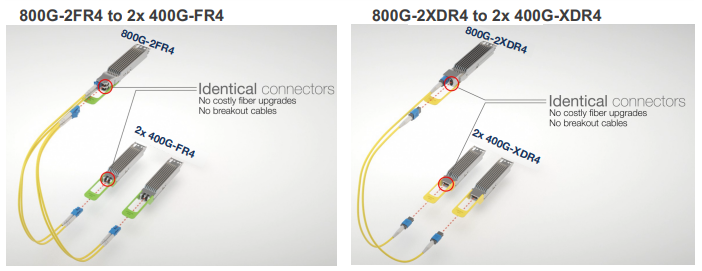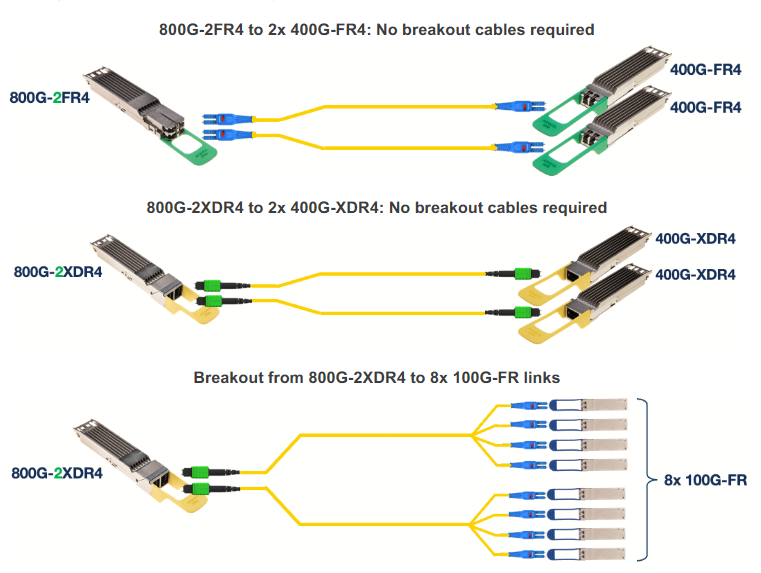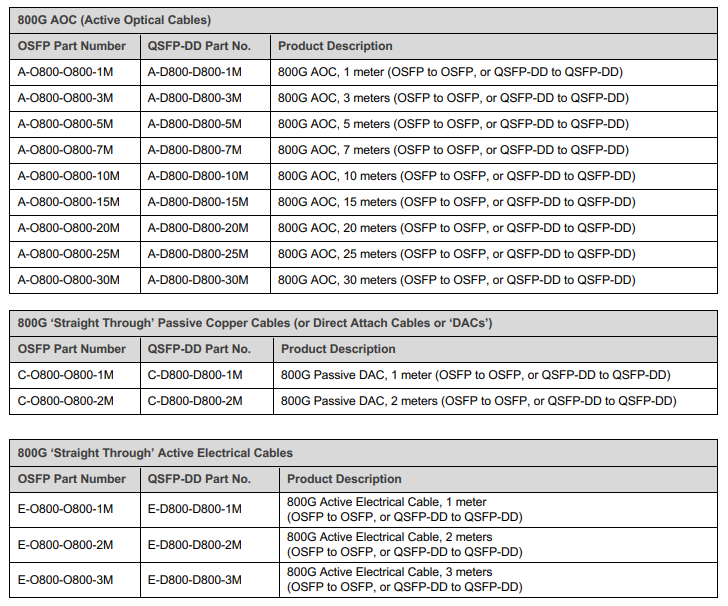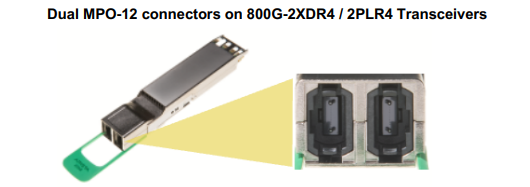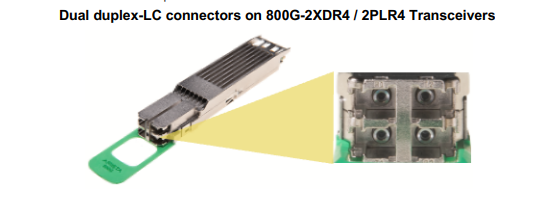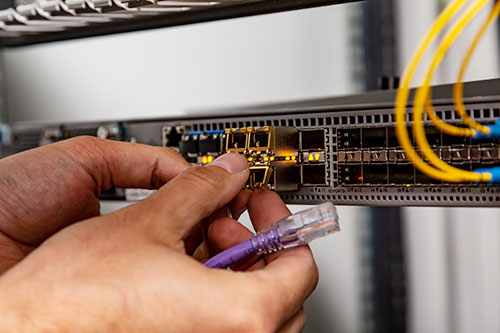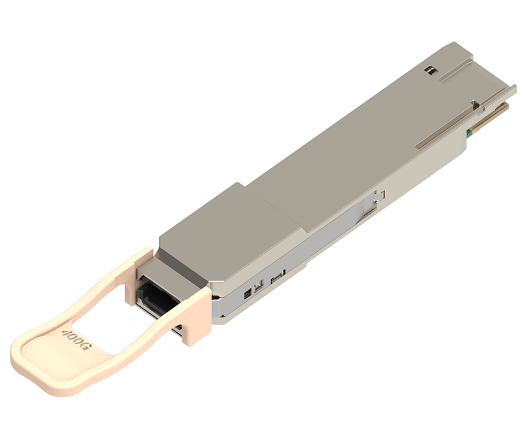Q、What are the benefits of moving to 800G technology?
A、Walsun’s 800G platforms allow data centers and high-performance computing environments to address growing needs for higher bandwidth at lower cost and power per gigabit. Key benefits include:
• Increase switching bandwidth by a factor of 2 when compared to 400G/port systems. Migrating from a 32x 400G/port to a 32x 800G/port system doubles the bandwidth density from 12.8T / RU to 25.6T / RU.
• Easy aggregation of 400G links: All 800G/port systems can be configured as 2x 400G, and all Walsun 800G optics allow 2 physically distinct 400GE links without the need for optical breakout cables.
• High density 400G and ultra-high density 100G: A 32 port 1RU 800G system enables 64 ports of 400GE, or 256 ports of 100GE in a single RU. Walsun offers 800G optics that enable 2x 400GE and 8x 100GE connectivity that interoperate with existing 400G and 100G optics.
Easy 800G to 2x 400GE Connectivity: No change to fiber plant
Q、What form-factors are used for 800G optics and cables?
A、800G optics and cables use the same form-factors used by 400G optics, the OSFP and the QSFP-DD. Walsun supports both form-factors, and Walsun 800G platforms are offered in both OSFP and QSFP-DD variants.
• The OSFP: The OSFP stands for “Octal Small Form-factor Pluggable”. It is described as an “Octal” module because the electrical interface of an OSFP connector consists of 8 electrical lanes. When used for 800G, each electrical lane is modulated at 100Gb/s, for a total of bandwidth of 800Gb/s.
• The QSFP-DD: The QSFP-DD stands for “Quad Small Form-factor Pluggable (QSFP) – Double Density (DD)”. The QSFP-DD form factor is similar to the QSFP form factor, with an additional second row of electrical contacts to increase the number of high-speed electrical lanes from 4 (in a QSFP) to 8 (in a QSFP-DD). When used for 800G, each electrical lane of the QSFP-DD is modulated at 100Gb/s, for a total bandwidth of 800Gb/s.
Q、What 800G Transceivers and Cables are available from Walsun?
A、Walsun supports a range of 800G optical transceivers, Active Optical Cables (AOCs), Direct Attach Copper cables (DACs), and Active Electrical Cables (AECs) in both OSFP and QSFP-DD form factors. The tables below summarize the 800G connectivity options supported. Additional media types will be added over time.
| 800G Optical Transceivers | ||
|---|---|---|
| OSFP Part No. | QSFP-DD Part No. | Product Description |
| OSFP-800G-2FR4 | QDD-800G-2FR4 | 2x 400GBASE-FR4 / 200GBASE-FR4 Dual-Rate Transceiver, dual LC connectors, up to 2km over dual duplex SMF. Interoperates with 2x 400G-FR4 OSFP / QSFP-DD, or 2x 200G-FR4 QSFPs. |
| OSFP-800G-2LR4 | QDD-800G-2LR4 | 2x 400GBASE-LR4 / 200GBASE-LR4 Dual-Rate Transceiver, dual LC connectors, up to 10km over dual duplex SMF. Interoperates with 2x 400G-LR4 OSFP / QSFP-DD, or 2x 200G-LR4 QSFPs. |
| OSFP-800G-2XDR4 | QDD-800G-2XDR4 | 2x 400GBASE-XDR4 Transceiver, Dual MPO-12 connector, 2km over parallel SMF. Interoperates with 2x 400G-XDR4 OSFP / QSFP-DD, and 8x 100G-FR QSFPs. |
| OSFP-800G-2PLR4 | QDD-800G-2PLR4 | 2x 400GBASE-PLR4 Transceiver, Dual MPO-12 connector, 10km over parallel SMF. Interoperates with 2x 400G-PLR4 OSFP / QSFP-DD, and 8x 100G-LR QSFPs. |
The diagrams below illustrate connectivity between 800G optics to 2x 400G optics, and breakout to 8x 100G links.
Q、Can OSFPs be plugged into a QSFP-DD port, or QSFP-DD’s plugged into an OSFP port?
A、No. The OSFP and the QSFP-DD are two physically distinct form factors. For OSFP systems, OSFP optics and cables must be used, and for QSFP-DD systems, QSFP-DD optics and cables must be used.
Q、Can an OSFP on one end of an 800G link interop with a QSFP-DD on the other end of a link?
A、Yes. The OSFP and QSFP-DD describe the physical form factor of the module. If the Ethernet media types are the same, the OSFP and QSFP-DD modules will interop with each other.
Q、Can 400G OSFP / QSFP-DD modules be plugged into 800G OSFP/QSFP-DD ports?
A、Yes. Arista 400G modules will be detected and enabled upon insertion into Arista switches, provided that the physical form-factor is compatible (i.e. OSFPs cannot be plugged into QSFP-DD ports and vice versa).
Q、Can 800G OSFP / QSFP-DD optical transceivers be plugged into 400G OSFP/QSFP-DD ports?
A、In some instances – under two conditions.
i) The 800G module must be capable of operation at ½ speed (with each electrical lane running at 50G PAM-4 instead of 100G PAM-4). The 800G-2XDR4 / 2PLR4 optics are not capable of dual-rate operation, so they cannot be used in 400G ports. Arista’s 800G-2FR4/LR4 transceivers, AOC and DAC cables can operate at ½ speed.
ii) The 400G switch port must be capable of supporting the higher power draw of 800G modules. 800G modules draw more power than 400G modules, so should only be used in 400G platforms capable of powering and cooling the 800G modules. Refer to the transceiver and cable datasheet for transceiver power consumption, and Arista 400G switch platform datasheets for details on specific systems.
Q、Can QSFP optical modules be used in OSFP ports?
A、Yes. An QSFP (40G or 100G) optical module can be inserted into an OSFP port by using a simple mechanical adapter. This adapter is available from Arista, with part number ADPT-O-Q-100G. The adapter, and the adapter with a QSFP plugged into it, are shown below.
When using a QSFP module in an OSFP port, the OSFP port must be configured for a data rate of 100G (or 40G), instead of 400G or 800G.
Q、Can I plug a 100G QSFP module into a QSFP-DD port?
A、Yes. A QSFP (40G or 100G) module can also be inserted into a QSFP-DD port (without a mechanical adapter). When using a QSFP module in an QSFP-DD port, the QSFP-DD port must be configured for a data rate of 100G (or 40G), instead of 400G or 800G.
Q、What do the suffixes “400G-XDR4 / PLR4, 400G-FR4 / LR4, 800G-2XDR4 / 2PLR4, and 800G-2FR4 / 2LR4” stand for?
A、The letters are reach specifications, and the number refers to the number of optical channels:
i) 400G-XDR4 and 400G-PLR4: “XDR” stands for “eXtended Reach DR”, and “PLR” stands for “Parallel Long Reach”. XDR4 / PLR4 optics have a reach of 2km / 10km using single-mode fiber, and the “4” indicates there are 4 optical channels. Each of the 4 optical channels are carried on separate fibers, resulting in a total of 4 pairs of fibers (4 fibers for Tx and 4 fibers for Rx). Each optical channel operates at 100Gb/s, enabling a total bandwidth of 400G. 400G-XDR4 / PLR4 interfaces use an MPO-12 connector to connect to 4 fiber pairs.
ii) 800G-2XDR4 and 800G-2PLR4: Refers to 2x “400G-XDR4” or 2x “400G-PLR4” interfaces, as described above. 800G-2XDR4 / 2PLR4 modules have 2x MPO-12 connectors, enabling 2 physically distinct 400G-XDR4/PLR4 links from each 800G transceiver without the need for optical breakout cables. The image below illustrates the dual MPO-12 connectors used in an OSFP-800G-XDR4 transceiver.
iii) 400G-FR4 / LR4: “FR” / “LR” refers to 2km / 10km reach using SMF, and “4” indicates there are 4 optical channels. All 4 optical channels from a 400G-FR4 / LR4 module are multiplexed onto one fiber in each direction (1 Tx fiber and 1 Rx fiber). Each optical channel operates at 100Gb/s, enabling 400G for each 400G-FR4/LR4 interface over a single fiber pair. 400G-FR4 / LR4 modules use a duplex LC optical connector.
iv) 800G-2FR4 / 800G-2LR4: Refers to 2x “400G-FR4” or 2x “400G-LR4” interfaces as described above. 800G-2FR4 / 2LR4 modules have 2 duplex LC connectors, enabling 2 physically distinct 400GFR4/LR4 links from each 800G transceiver without the need for optical breakout cables. The image below illustrates the dual LC-duplex connector used on the OSFP-800G-2FR4 transceiver.

